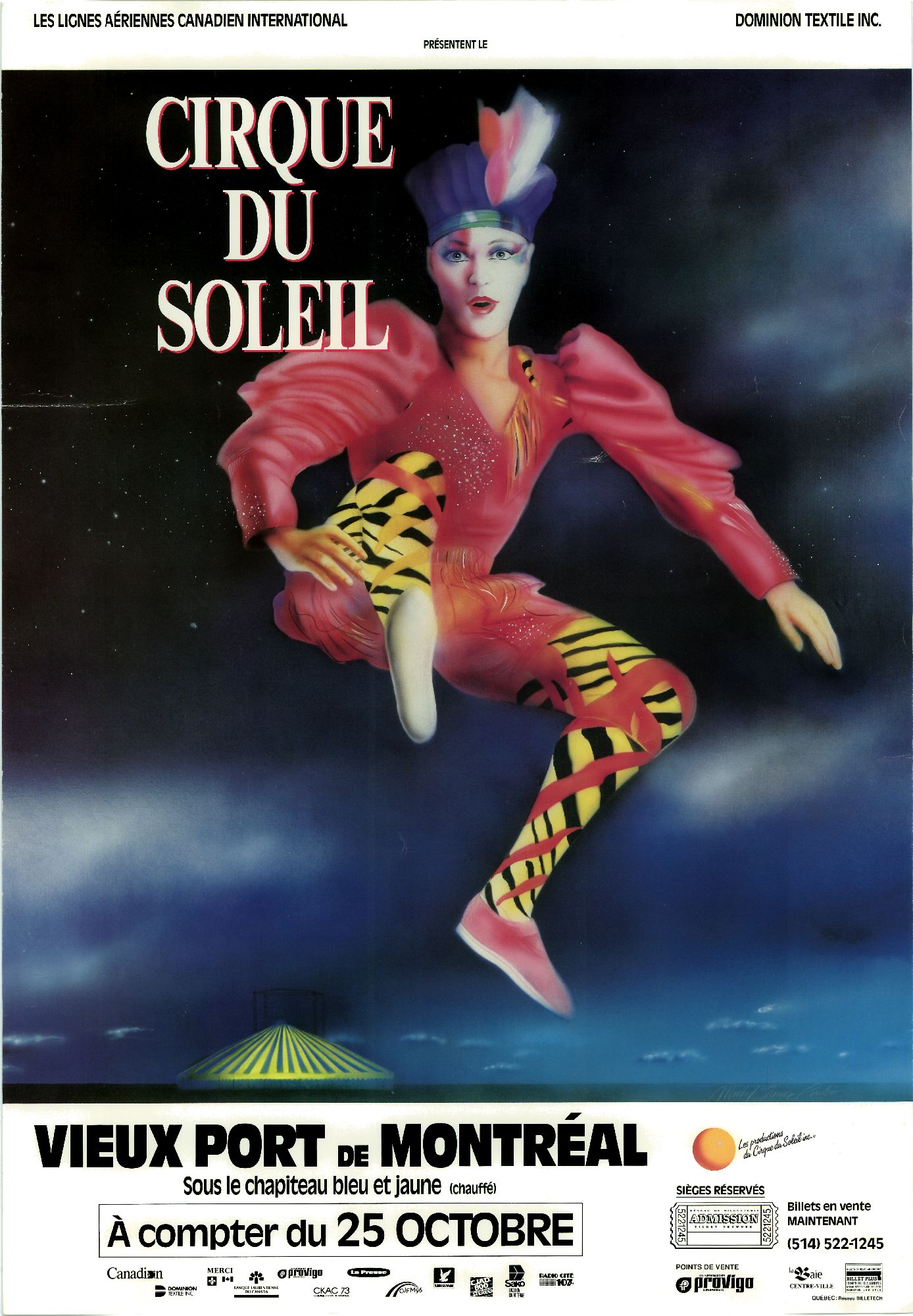

| |
 |
1988 |

THE CIRCUS AS A BUSINESS?
With all the fire and optimism of youth, Cirque du Soleil set out to
reinvent the art of the circus, an art hitherto almost unknown in Canada.
Back in that first year, we already had the feeling that nothing would come
between us and the realization of their cherished dream. And indeed, in
the space of four short years, the Cirque du Soleil has become a success
story, gaining recognition not only in Quebec and Canada but also
internationally.
This tremendously gratifying achievement would never have been possible
without the unflagging determination creativity and willingness to go one
step further displayed out by every member of our company. This was especially
true for 1987, the year of Cirque's first appearances in the United States
and a tour of California that can only be described as a triumph. Although
Cirque's still basking in the glow, we've no intention of resting on our
laurels.
This year - 1988 - is the last year of our five-year plan, and a very
important point in the evolution of the Cirque du Soleil. To consolidate
our breakthrough in the American market, we've set our sights on the Eastern
US. The challenge is colossal, but our accomplishments of the last four
years told us we can do it! – Guy Laliberté.
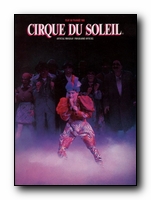 Far from being polar opposites, Cirque du Soleil proves that creativity
and business go together like hand and glove. When asked what makes him
tick, Guy Laliberté responds, as artist and administrator, that his goal
remains to surpass himself. "Anything is possible," he says, "if you're
prepared to do what it takes to make it worthwhile." In his case, that
means unswerving determination, the kind of honesty that inspires immediate
respect and a very rare gift of intuition, plus the many other qualities
of Guy's unique personality. All of which are inseparably bound up with
the destiny of the Cirque du Soleil, and the company's growing reputation
for fresh thinking, sharp business acumen and second-to-none standards
of quality.
Far from being polar opposites, Cirque du Soleil proves that creativity
and business go together like hand and glove. When asked what makes him
tick, Guy Laliberté responds, as artist and administrator, that his goal
remains to surpass himself. "Anything is possible," he says, "if you're
prepared to do what it takes to make it worthwhile." In his case, that
means unswerving determination, the kind of honesty that inspires immediate
respect and a very rare gift of intuition, plus the many other qualities
of Guy's unique personality. All of which are inseparably bound up with
the destiny of the Cirque du Soleil, and the company's growing reputation
for fresh thinking, sharp business acumen and second-to-none standards
of quality.
"We don't pretend to invent the human performance of the circus," says
artistic director Guy Caron, "but the wrapping, the form and presentation, then
tie it together into one theatrical whole - like the opera."
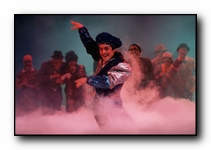 Not only did the Cirque forge ahead; it was able to decrease its
dependency of government grants to 50% in 1985 and 27% in 1986, by seeking
out and developing ties with private industry. In 1987, government
subsidies accounted for only 15% of the company's operating budget. A
turning point was reached when the Cirque headed south across the border
last summer after a tour of Quebec and performed the opening of the prestigious
Los Angeles Festival before embarking on a three-month tour of California.
The praise was enthusiastic and the tour got extensive media coverage.
Not only did the Cirque forge ahead; it was able to decrease its
dependency of government grants to 50% in 1985 and 27% in 1986, by seeking
out and developing ties with private industry. In 1987, government
subsidies accounted for only 15% of the company's operating budget. A
turning point was reached when the Cirque headed south across the border
last summer after a tour of Quebec and performed the opening of the prestigious
Los Angeles Festival before embarking on a three-month tour of California.
The praise was enthusiastic and the tour got extensive media coverage.
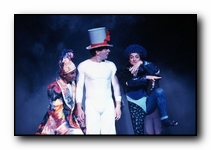 Meanwhile, the Cirque was turning heads in the Quebec business community
for its success in exporting - of all things - a cultural event. New openings
led to an internal reorganization that included provisions for indoor
performances, the rental of the circus' costume and set production facilities
and the marketing of secondary products such as tee-shirts, coloring books,
educational toys, video-cassettes and records.
Meanwhile, the Cirque was turning heads in the Quebec business community
for its success in exporting - of all things - a cultural event. New openings
led to an internal reorganization that included provisions for indoor
performances, the rental of the circus' costume and set production facilities
and the marketing of secondary products such as tee-shirts, coloring books,
educational toys, video-cassettes and records.
A LITTLE TROUBLE DOWN UNDER
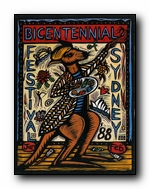 January 1988 marked Australia's 200th anniversary, which was to be celebrated with a
two month "Bicentennial Festival" in Sydney. Cirque du Soleil was invited and later
accepted an invitation to perform at the festival, as well as a tour through the rest
of Australia (Sydney, Brisbane, Melbourne and Canberra) that would have lasted through
May of that year. However, citing increased travel costs and a less than cordial welcome
from some Australians, Cirque du Soleil withdrew from its scheduled appearance at the
Festival and canceled their entire Australian tour. "We feel we're not welcome here,"
Latourelle said. "It's like trying to give a gift and then having it thrown back into
your face."
January 1988 marked Australia's 200th anniversary, which was to be celebrated with a
two month "Bicentennial Festival" in Sydney. Cirque du Soleil was invited and later
accepted an invitation to perform at the festival, as well as a tour through the rest
of Australia (Sydney, Brisbane, Melbourne and Canberra) that would have lasted through
May of that year. However, citing increased travel costs and a less than cordial welcome
from some Australians, Cirque du Soleil withdrew from its scheduled appearance at the
Festival and canceled their entire Australian tour. "We feel we're not welcome here,"
Latourelle said. "It's like trying to give a gift and then having it thrown back into
your face."
The brouhaha began when
the Australian Actors Equity and the country's Circus Oz objected to Cirque's plans,
especially one week in which Cirque's appearance in Sydney would have coincided with
a Circus Oz run. "We were very vulnerable to comparison with them," said Circus Oz
administrator Susan Provan, "and we thought we just couldn't compete with their
promotional campaign." So Circus Oz asked Cirque "to revise their dates and not
appear until four to six weeks after we did in any city," said Provan. When Cirque
wouldn't budge, "we lodged a request with the immigration department to put pressure
on them to alter their dates." Immigration officialls eventually overruled the
objections and granted Cirque du Soleil the necessary visas, but by then cut-rate
airline tickets were no longer available. The company would have to fly business class.
And the cost of shipping the circus' 320 tons of equipment on short notice would have
reached $1.5 million CDN - "double what we had expected to pay," sad Latourelle. Cirque
had expected to lose money in Australia anyway, but these extra costs, said Latourelle,
"would have risked the failure of the company."
At the urging of festival officials, Latourelle flew to Australia to try to rescue
the Sydney portion of the tour. But the negotiations, which centred on the option of
Cirque du Soleil leaving behind its fleet of blue trucks which transport the circus's
restaurant, laundry, kitchen and sleeping facilities, seemed doomed to failure. The
major stumbling block was that unless the equipment can be returned to Los Angeles by
air after the Sydney dates, the troupe would be unable to perform for five weeks. And
air freight would be prohibitively expensive. Under Cirque du Soleil's contract with
its staff, performers must be paid for any vacation time longer than two weeks. "I
can't give five weeks off to everybody. It's impossible," said Latourelle. Had the
company done the full Australian tour, he said, the last two weeks in Brisbane, at
Expo '88, would have been without the company's six-story Big Top, so that the
equipment could set sail for Los Angeles before the performers. Latourelle said he was
advised by his technical crew yesterday afternoon that because of the difference betwen
North American and Australian voltages, the company's own electrical van would have
to be transported to and from Australia, and the 45-foot van would simply not fit on
a plane. And so the company pulled out. Unfortunately, the Festival's programme books
had already been printed...
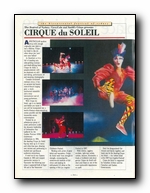
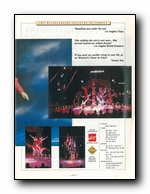
VIA THE MOON OR MARS?
Australia's loss was California's gain. Cirque du Soleil returned to Santa
Monica in February 1988 ("Le Cirque comes to us from Montreal, but surely via the moon
or Mars!" — The Los Angeles Times), appeared at the Calgary Winter Olympics
as planned (for four performances on the final weekend; they performed indoors so
the big top was left in Santa Monica so as to continue performances there), then wowed
audiences in San Francisco throughout the month of April. By summer, though, Cirque du Soleil had
set its sights on a new conquest - The Big Apple - and the troupe next found its blue
and yellow big top pitched in the shadows of the World Trade Center in New York City.
Excited, though hesitant, the artists wondered how jaded Manhattanites would take their
scrappy circus from Quebec. They needen't have worried; their reputations, which they
secured in California, preceeded them. "If the eagerly awaited New York reviews
published today are as positive as the crowd's reaction last night," the Montreal
Gazette wrote. "Cirque du soleil will soon be able to add the Big Apple to its
list of conquests." And it did. Le Cirque took Manhattan and quickly became one of
the hottest tickets in New York!
The phones at the Cirque du Soleil box office have been ringing off the hook to
the tune of an astonishing 2,500 tickets sold [May 26th] alone. And that's even before
the reviews in the major New York dailies - the New York Times, New York Post and the
Daily News - have appeared. Cirque du Soleil's entire New York run, which has now been
extended until July 10, is expected to be sold out by June 15th. The approximately 80
members of the Cirque du Soleil family barely had time to catch their breaths after
Wednesday night's premiere performance before an army of television crews ranging from
Quatre Saisons to MTV descended on the caravan of mobile units surrounding the blue
and yellow big-top tent site at Battery Park City in Lower Manhattan.
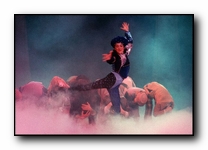 Cirque du Soleil's vice-president and general manager, Normand Latourelle, who spent
much of the last month worrying about New York, was overwhelmed. "I'm in the Jell-O
today," Latourelle told one reporter. "It just could not be any better. It was so much
stress. Now, my head - a piece of gelatin." Yep, the Cirque du Soleil, the sassy,
classy little Canadian circus, hit the big time. Scalpers selling $37 tickets for
$200. A steady stream of breathless reviews. Hip Hollywood stars smitten with the show.
That's what's been happening for the last 10 months as Cirque du Soleil bowled over
critics and audiences on a triumphant tour of Los Angeles, San Francisco, and New York.
Heady stuff, writes The Windsor Star, especially since four years ago the Cirque was
just a ragtag bunch of youthful street performers. But the troupe's smash success south
of the border didn't really surprise Cirque co-founder Guy Laliberté. "I never had any
doubts that success would come," Laliberté said. "What did surprise me was the
intensity of the reaction, things like Jane Fonda coming to the show seven times.
The Americans are fanatics about us."
Cirque du Soleil's vice-president and general manager, Normand Latourelle, who spent
much of the last month worrying about New York, was overwhelmed. "I'm in the Jell-O
today," Latourelle told one reporter. "It just could not be any better. It was so much
stress. Now, my head - a piece of gelatin." Yep, the Cirque du Soleil, the sassy,
classy little Canadian circus, hit the big time. Scalpers selling $37 tickets for
$200. A steady stream of breathless reviews. Hip Hollywood stars smitten with the show.
That's what's been happening for the last 10 months as Cirque du Soleil bowled over
critics and audiences on a triumphant tour of Los Angeles, San Francisco, and New York.
Heady stuff, writes The Windsor Star, especially since four years ago the Cirque was
just a ragtag bunch of youthful street performers. But the troupe's smash success south
of the border didn't really surprise Cirque co-founder Guy Laliberté. "I never had any
doubts that success would come," Laliberté said. "What did surprise me was the
intensity of the reaction, things like Jane Fonda coming to the show seven times.
The Americans are fanatics about us."
Yes, they were. Wherever it went the result was the same: rave reviews and sold-out performances
went hand-in-hand. 796,937 people had now seen Le Cirque Réinventé.
Despite the cold Canadian winter, the company
ended its 1988 tour triumphantly at home in Montreal. There, as well as all over the
continent, Cirque du Soleil wins many awards for its entrepreneurship and its
innovative and creative spirit: including Emmy, Drama Desk, Bambi and Ace
awards, Gémeaux and Félix trophies, and a Rose d'Or de Montreux. Cirque du
Soleil's performers take part and win several awards at various festivals
throughout the world, including the Festival international du cirque de
Monte-Carlo, the Festival mondial du cirque de demain (France), the Festival
international de cirque de Vérone (Italy), the Festival international de
cirque de Gênes (Italy), and the Wuhan International Acrobatic Art Festival
(China). And with the proportion of government funding down to 10% and its
budget in the $10 million range, the Cirque du Soleil had met its objectives.
"We never doubted ourselves," says Laliberte, "we worked hard and we're now
reaping what we have sowed." That includes some pretty impressive financial
benefits.
But not everyone is happy.


|
|
|
|


![]()





![[Back]](../images/arrow.gif)









